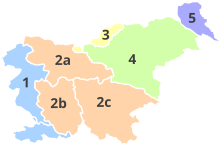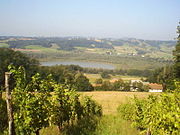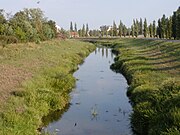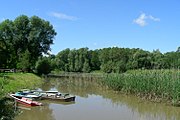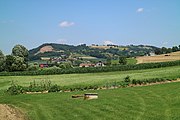Prekmurje
Prekmurje , German Übermurgebiet , Hungarian Muravidék ('Mur Land') is a region in the extreme northeast of Slovenia . The area has an area of 950 km² and includes the hilly Goričko , the plains Ravensko and Dolinsko and the western part of the mountainous Lendavske Gorice .
The part of the country is named after the river Mur , which once separated the Slovenes living in Hungary from the Cisleithan in Lower Styria . The economic and cultural center of Prekmurje today is the city of Murska Sobota . A Hungarian minority lives in the north and east and has the right to a seat in the Slovenian parliament. It is the poorest region in Slovenia.
geography
The Prekmurje borders on Austria and Hungary ( triangle / Tromejnik 387 m) and slightly on Croatia ( Mur to the mouth of the river Ledava ).
The region is a hilly m with heights between about 150 and 400: The Goricko provide a morphological continuation of oststeirischen hills represent that in the Vasi Hegyhát and Zalai-dombság Western Hungary, the Lendavske gorice (Unterlimbacher hills) and the Međimurje (Zwischenmurland) Croatia continues as the last foothills of the Alps. The main river is the Ledava (Lendva / Limbach), which flows through the northeast part of the Mur plain ( Pomurska ravan ). This forms the southeast and southern part of the Prekmurje. The highest point is the 418 m. i. J. high Sotinski breg on the border with Austria.
The two most important road connections run in north-south direction: the one in the west runs parallel to the Styrian border and at Neuhaus - Bonisdorf into southern Burgenland , Austria , the other turns in the middle of the country at Petrovci - Šalovci in an easterly direction to Hungary.
The hill-top wine-growing village of Križevci
Ledavsko jezero reservoir
Sotinski breg from the south
Important places

- Murska Sobota (German: Olsnitz ) (capital, 20,000 inhabitants)
- Beltinci (German: Altfellsdorf ),
- Črenšovci (in the south)
- Dobrovnik (German: Dobronack ),
- Lendava (German: Limbach ) (in the east)
- Turnišče (German: Thurnitz ) (middle)
Other places:
- Fokovci , Hodoš (German: Hodosch ) (in the east, on the border with Hungary )
- Sotina (German: Stadelberg ),
- Mačkovci (German: Waldbach ) (in the northwest)
- Šalovci
Border towns to Austria:
Neighborhood:
- Nearest major Slovenian city: Maribor (Marburg), 60 km
- Neighboring towns in Austria: Bad Radkersburg (Styria), Windisch-Minihof and Jennersdorf (Burgenland)
- in Hungary: Szentgotthárd , Őriszentpéter , Lenti (near Lendava)
history

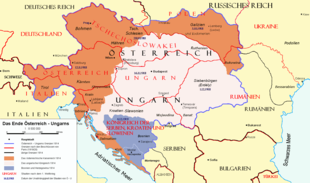
The Slovenian settlement area has belonged to the Habsburg monarchy since the beginning of modern times . The area north of the Mur had already been part of the Kingdom of Hungary in the Middle Ages , before it came to Austria as Royal Hungary during the Turkish wars in 1527/38 . West bordering Stajerska the Duchy Steyer (Styria) in which Slovenian heartland and the coast were the Duchy of Krain . This makes Prekmurje the only part of present-day Slovenia that did not belong to the Holy Roman Empire . The population of the area was mixed Hungarian and Slovenian, with smaller German areas.
It was divided into the counties Vas (Železna županija, dt. Eisenburg) in the north, and Zala (Zalska županija, Zala) in the south, whereby it was the Járási (chair districts) Muraszombat around Muraszombat / Olšnica / Olsnitz (today Murska Sobota) respectively Alsólendva with the main town Alsólendva / Dolenja Lendava / Unterlimbach, (today Lendava) formed. The Slovene settlement extended even further north towards Raab and Szentgotthárd (Monošter, St. Gotthard) , and was called Porabje ('Raab-Land'). This whole area together was called Vendvidék (Wendenland, Windisches Land) in Hungarian , very similar to the Styrian and Carinthian parts.
After the disintegration of the Habsburg Monarchy in 1918, the Prekmurje , which belonged to Hungary , formed the Mura Republic (Republic of Prekmurje) of the Slovene ethnic group in 1919 , but this only existed for six days. After the suppression of the secession , the Slovene ethnic group in the area demanded a union with the Slovene-dominated Lower Styria, which had belonged to the new SHS state (Kingdom of Yugoslavia) since 1918 . With the Treaty of Trianon in 1920, Prekmurje was actually separated from Hungary and placed under the SHS state; Burgenland (German West Hungary) also came to Austria.
After the Balkan campaign in spring 1941, the Prekmurje first came back to Hungary and after the end of the war in 1945 back to Yugoslavia, where it was assigned to the new member state of the Socialist Republic of Slovenia . The constituent state (with the Prekmurje) became the independent Republic of Slovenia in 1991 , which joined the EU in 2004 .
The three-country corner at Sichauf and Ocinje and the border mountain Burgenland-Styria-Slovenia remind of the different phases, and the three-country corner near Oberdrosen and Dolič reminds of the current state . Both are set up as documentation centers and have been freely accessible since Slovenia joined the EU in 2004.
Culture and sights
The Slovenian population speaks a local dialect which Prekmürščina (Prekmurje Slovene) , a ostslowenischer dialect of the Međimurje - such as the Burgenland-Croatian and is related, marked by the long belonging to Hungary. It was already written down in the 18th century and has retained its independence from standard (Krainer) Slovenian.
Food specialties:
- Prekmurska gibanica
- Bograč (a type of goulash)
- Bujta repa
- Dödoli (potato dish)
A large part of the Prekmurje belongs to the transnational Raab-Őrség-Goričko Nature Park .
Web links
- Krajinski park Goričko (park-goricko.org) - Slovenian website of the nature park
- Prekmurje na dlani (prekmurje-slo.com) - a tourism website for the area
- Prekmurje in Porabje (prekmurje.si) - a private website about the area with photos
